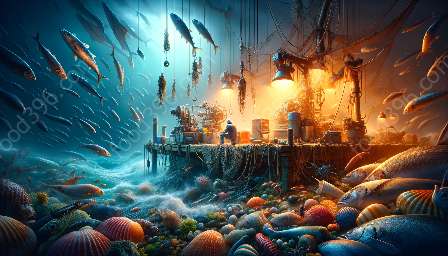Fish processing involves a range of technologies and equipment that play a vital role in transforming harvested fish into safe, high-quality seafood products. From harvesting and handling to processing and packaging, this comprehensive guide explores the diverse methods and tools used in fish processing, highlighting their relevance to fishing technology and equipment, as well as their impact on seafood science.
Harvesting and Handling
Effective fish processing begins with the proper harvesting and handling of fish. Fishing technology and equipment, such as trawlers, purse seines, and longlines, are used to capture fish sustainably and efficiently. Once caught, the fish must be handled carefully to minimize stress and maintain quality. This includes techniques such as bleeding, gutting, and chilling, supported by specialized equipment like on-board refrigeration systems and insulated storage containers.
Primary Processing
Once the fish reach the processing facility, they undergo primary processing, which involves initial cleaning, filleting, and portioning. Modern advancements in fish processing technologies have introduced automated filleting machines, precision cutting equipment, and high-pressure processing (HPP) systems, which ensure precision and efficiency while maintaining the integrity of the fish flesh. Equipment such as conveyors, knives, and vacuum packaging machines are essential in this stage, streamlining the workflow and preserving the fish's freshness.
Secondary Processing and Value-Added Products
Secondary processing encompasses value-added activities that transform fish into a wide array of products, such as fish fillets, smoked fish, fish cakes, surimi, and fish meal. Advanced fish processing technologies such as smoking kilns, freeze-drying chambers, and extrusion machines facilitate the production of these diverse products while maintaining their nutritional value and extending shelf life. Quality control equipment, including metal detectors, X-ray machines, and moisture analyzers, ensures the safety and quality of the final products.
Packaging and Preservation
Efficient packaging and preservation technologies are critical for maintaining the quality and safety of seafood products. Vacuum packaging machines, modified atmosphere packaging (MAP) systems, and freezing tunnels are employed to package and preserve fish products, safeguarding them from microbial spoilage and oxidation. Additionally, smart packaging technologies equipped with temperature sensors and freshness indicators provide real-time monitoring of product conditions, ensuring optimal storage and distribution.
Waste Management and Sustainability
Throughout the fish processing chain, sustainable practices and waste management strategies are vital. Innovations in fish processing equipment, such as anaerobic digesters for organic waste, fish oil extraction systems, and biodegradable packaging materials, contribute to reducing environmental impact and maximizing resource utilization. These initiatives align with the principles of seafood science, promoting responsible and eco-friendly approaches to fish processing.
Integration with Fishing Technology and Equipment
The evolution of fish processing technologies and equipment is closely intertwined with advancements in fishing technology and equipment. Innovations in fishing gear, fish finders, and vessel monitoring systems directly impact the quantity and quality of fish that enter the processing chain. Similarly, the development of processing machinery and automation systems enhances the efficiency and precision of fish processing, reflecting the symbiotic relationship between these two domains.
Role in Seafood Science
Fish processing technologies and equipment play a pivotal role in seafood science by facilitating research and development, quality assessment, and safety evaluations. State-of-the-art analytical instruments, such as spectroscopy devices and microbial testing equipment, enable rigorous analysis of seafood products, ensuring compliance with regulatory standards and consumer expectations. Furthermore, ongoing collaborations between seafood scientists and industry professionals drive innovation in processing technologies, addressing emerging challenges and opportunities in the seafood sector.
From the initial stages of harvesting to the final packaging, fish processing technologies and equipment form an integral part of the fishing industry, enhancing efficiency, sustainability, and quality across the seafood supply chain.

